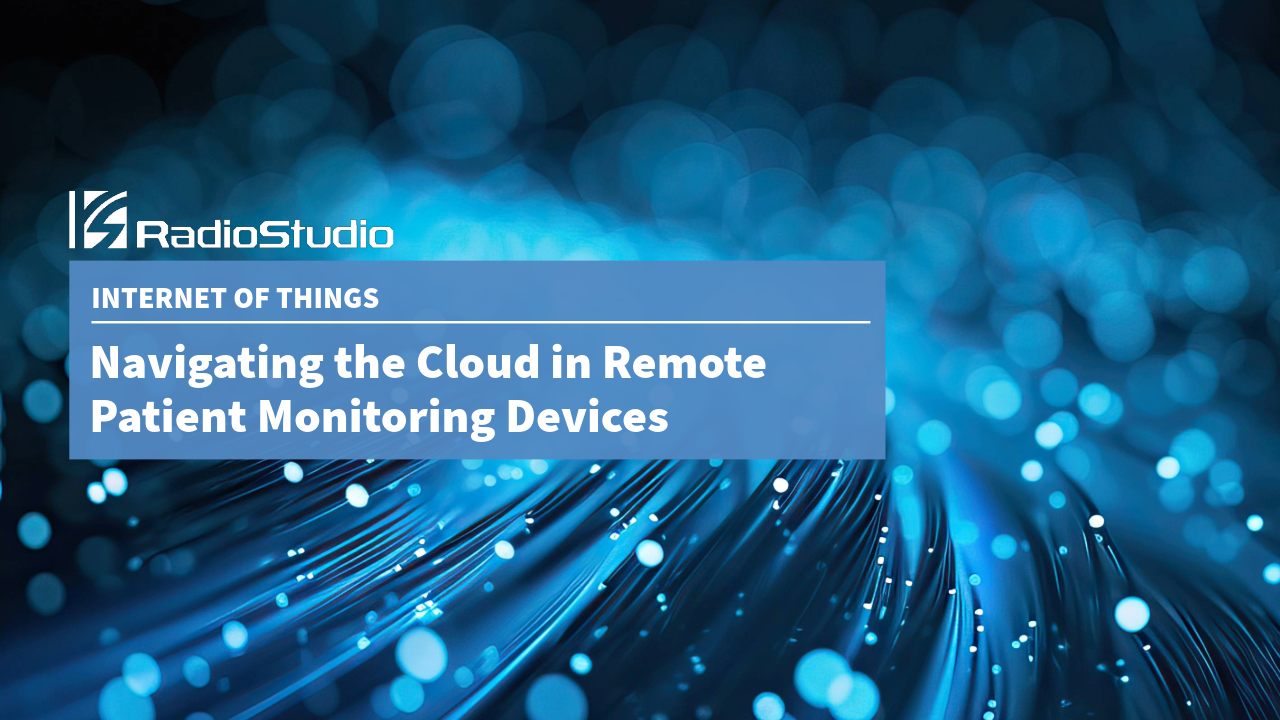Remote patient monitoring (RPM) is poised to transform the healthcare landscape as we know it. Cloud connectivity is at the heart of this transformation, a technology that enables patient data to be transmitted from monitoring equipment to the cloud. It enables healthcare providers to remotely monitor patient health trends and take timely action when necessary.
This post was originally published in Blues.
Use Case: Remote Patient Monitoring

Problem Statement
Remote patient monitoring encounters limitations due to a lack of cloud connectivity. But even in the case of availability of connectivity, there are additional challenges due to reliability, privacy, security and more.

Realization Approach
A pre-provisioned, remote patient monitoring device ensures that the entire hardware system is pre-configured and ready to deploy, with cellular data plans pre-baked into the system.

Solution Space
Uninterrupted cloud connectivity for remote patient monitoring systems ushers in a new era of data-driven healthcare such that massive datasets generated by healthcare devices can be harnessed to identify broader health trends, optimize treatments, and even predict health issues before they become critical.
The Changing Landscape of Healthcare
The traditional model of healthcare, confined to the four walls of a hospital or clinic, is rapidly evolving. Patients, especially senior citizens, now strongly desire to ‘age in place’. This means they want to receive healthcare while remaining in the familiar surroundings of their homes. This shift in perspective presents a remarkable challenge and opportunity for healthcare providers.
Simultaneously, the healthcare industry is moving away from the old paradigm of one-size-fits-all care. In its place, it’s adopting a proactive, data-driven approach. With technological advancements, healthcare professionals have access to vast amounts of patient data. This data is a veritable goldmine for anticipating health trends, intervening early, and delivering personalized treatments.
A growing commitment to health equity is another factor reshaping healthcare. The goal is to make healthcare accessible to everyone, regardless of their financial means or geographic location. Remote patient monitoring is pivotal in this endeavor, ensuring healthcare services reach even the most underserved populations.
But while the future is promising, it’s essential to recognize the challenges ahead for RPM manufacturers as they navigate this transformative journey.
Key Challenges for Remote Patient Monitoring Device Manufacturers
Although RPM is a promising frontier in healthcare, it comes with unique challenges. Manufacturers in this field must navigate these intricacies diligently to develop reliable and efficient solutions.
- Reliability – Ensuring Data Integrity and Safety: The cornerstone of any RPM system is reliability. Unlike many other technologies where an occasional glitch may be a minor inconvenience, in healthcare, it could be a matter of life and death. RPM devices must maintain constant connectivity to ensure the integrity and safety of patient data. Even in challenging conditions, where connectivity might be limited, RPM devices must remain unwaveringly reliable and not leverage a solution that exclusively uses one connectivity technology but several redundancies.
- Availability — Overcoming Supply Chain Woes: The RPM ecosystem is highly dependent on a consistent supply chain. Delays or disruptions in the supply chain can have cascading effects, causing significant hurdles for manufacturers. The burden of managing supply chains often falls on RPM manufacturers. Any hindrance in procuring essential components can ripple through the production process, potentially affecting the availability of vital RPM devices.
- Compliance — Navigating the Regulatory Maze: Healthcare regulations, including the need for FDA clearance, present a formidable challenge to RPM manufacturers. Achieving compliance is a time-consuming and complex process that demands meticulous attention to detail. Regulatory bodies require comprehensive documentation and rigorous testing to ensure the safety and efficacy of RPM devices. Any alterations or updates to the device may necessitate revisiting the compliance process, which can significantly extend the time to market.
- Privacy and Security — Safeguarding Patient Data: RPM revolves around the sensitive realm of patient health data. Consequently, the issue of privacy and security looms large over this field. The stringent privacy laws and regulations surrounding healthcare underscore the critical need for robust cybersecurity measures. RPM systems must guarantee the confidentiality and integrity of patient information through strict data encryption, secure boot procedures, and regular over-the-air (OTA) security updates. These measures are not merely recommended but essential to maintaining patient trust and complying with legal requirements.
- Pre-provisioned — Ready to Deploy: The process of deploying RPM devices involves numerous intricacies. Traditionally, it required setting up and configuring various components, including data plans and SIM cards. For RPM manufacturers, the challenge lies in simplifying this process. The term ‘pre-provisioned’ encapsulates the need for RPM devices to come ready to deploy, with cellular data plans pre-baked into the system. This simplification of the deployment process can significantly reduce the time and resources required to get RPM devices up and running.
These challenges collectively represent a formidable landscape that RPM manufacturers must navigate. Addressing them comprehensively not only ensures the development of reliable and secure RPM solutions but also paves the way for a future where remote patient monitoring plays a pivotal role in healthcare delivery.
The Future of Remote Patient Monitoring Devices with Cloud Connectivity
Cloud connectivity is driving a transformative wave in the realm of RPM devices. It’s not just about monitoring health; it’s about empowering patients to lead healthier lives and ensuring healthcare providers have the tools they need to deliver timely care.
With cloud connectivity, RPM devices can seamlessly transmit critical patient data to secure, cloud-based servers. This enables healthcare professionals to monitor patient health trends in real time, facilitating early intervention when needed. Imagine a scenario where a patient’s vital signs change, triggering an alert, prompting immediate medical attention. Cloud-connected RPM devices make this a reality, ensuring patients receive timely care, even from the comfort of their homes.
Cloud connectivity is also ushering in a new era of data-driven healthcare. The massive datasets generated by RPM devices can be harnessed to identify broader health trends, optimize treatments, and even predict health issues before they become critical. This shift from reactive to proactive healthcare can potentially reduce healthcare costs, improve patient outcomes, and ultimately save lives.
Blues as Your RPM Connectivity Solution
Navigating the complex landscape of remote patient monitoring calls for a steadfast ally. That’s where Blues’ Notecard and Notehub step in. As a trusted partner, Blues is dedicated to addressing the challenges that RPM manufacturers encounter.
Our commitment to reliability ensures that your RPM devices, powered by Notecard and connected through Notehub, remain connected even in the most challenging conditions. Blues even builds Notecards with redundant cellular and even Wi-Fi failover built right in. We shoulder the burden of supply chain management, guaranteeing the availability of these cutting-edge technologies regardless of external disruptions.
Connecting RPM with Notecard and Notehub
Notecard and Notehub are the dynamic duo revolutionizing RPM. Notecard’s reliability is unmatched, ensuring that your RPM device maintains connectivity even in signal-challenged locations and safeguarding patient data integrity. When paired with Notehub, our ecosystem creates a seamless data transmission pipeline from patient equipment to the cloud, enabling real-time monitoring and proactive care.
When it comes to compliance, Blues simplifies the regulatory maze by offering FTC compliance benefits and handling crucial security aspects, such as encrypted “off the internet” communications and pre-loaded certificates through an integrated secure element. Our emphasis on privacy and security ensures that patient data, transmitted seamlessly through Notehub, remains safeguarded at all times.
With Blues, you get more than just a connectivity solution; you get a faithful ally. Our MinSpin service provides invaluable engineering support, making RPM product development swift and efficient. We abstract the complexities of connectivity with Notecard and Notehub, allowing you to focus on your core mission.
Let Blues be your partner in transforming healthcare through RPM. Talk to one of our experts to get started today.


